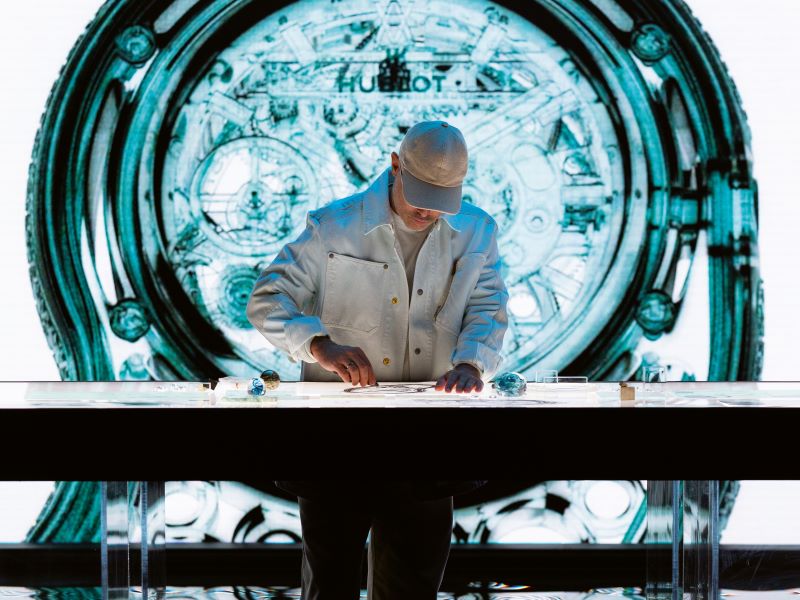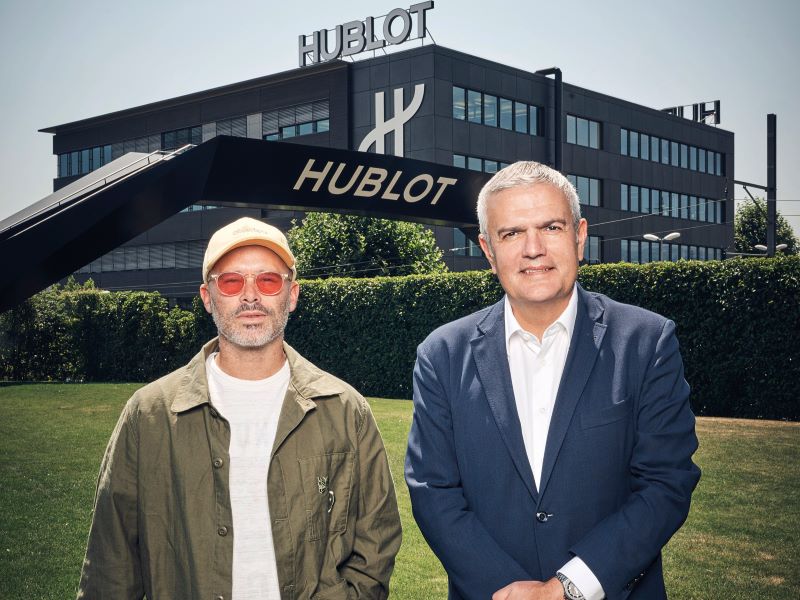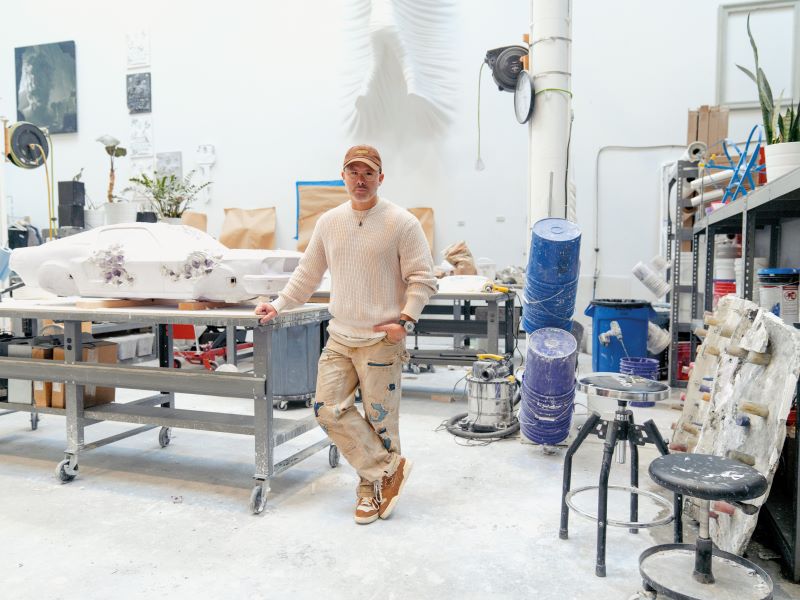
Arsham distorts structures and spaces by turning everyday objects into decaying relics (All photos: Hublot)
When dealing with the aftermath of a disaster, do you succumb or surmount? Overcoming life’s slings and arrows is not unfamiliar to Daniel Arsham, who survived Hurricane Andrew that ripped through his Miami home in 1992 by huddling in a concrete bunker. Whole neighbourhoods were cleaved, roofs whipped by the wind and cars swallowed by the earth. Violent meteorological activity hardly makes an optimistic topic for art or literature but Arsham, who confronted his own fragility in the face of it, was inspired by the concept of perishability in the environment and bodies we inhabit. Such “architectural dismemberment” nurtured his fascination and time on the easel.
The art graduate from New York’s The Cooper Union did not always paint but seeing red, or in fact, any other hues, would have prompted him to pick up the brush more. Born colour blind, he is able to see approximately 20% of the shades a person can normally distinguish. This explains why he is always wearing glasses that correct his deuteranopia, a genetic deficiency that cannot discern red or green, and that most of his works are in white or grey.
Not having the perfect chromatic pitch can be a fun affliction too: Objects lose their prescribed meaning, and colours can be integrated into things or symbols of pop culture like the radio, video game controller and camera that are, otherwise, traditionally monochromatic. Art through rose-tinted lenses, untroubled by social ills and political malaise, may be a happy place we could escape to.
In his nonpareil oeuvre, Arsham inhabits the role of an archaeologist, except instead of unearthing centuries-old objects, he turns everyday items into artefacts that appear as if they have been buried for ages. So, what do icons of today look like to a civilisation completely divorced from our own? Covered in sand, selenite or volcanic ash, an original Apple computer, Game Boy console, Sony Walkman, Back to the Future DeLorean car and Casio keyboard were redefined as haunting, decomposed relics. Why fixate on the present when it is only a vapour between past and future, his artworks seem to question.
arsham_inside.jpg

Asked about his starry associations, Arsham replies with a small flush of pride. The late dancer and choreographer Merce Cunningham, who died at 90 in 2009, was an uncompromising figure and mentor who dispensed storytelling through lyrical motion. Arsham designed the stage set for Cunningham’s eyeSpace, and later, Dior Men’s spring/summer 2019 runway show for fashion colossus Kim Jones. Creative crossovers are not recipes for making masterpieces but rather conduits for breaking habits and new grounds.
“I find it exciting to bring art to a place where people don’t necessarily expect to see it. The audience can’t really tell how they will be engaged. Kim Jones didn’t start the house [of Dior] but it’s interesting to see how he and others interpret a brand they are not particularly familiar with,” admits the 2003 recipient of the prestigious Gelman Trust Fellowship Award. Arsham is also one half of Snarkitecture, a design practice he set up with Alex Mustonen that constructs interactive art installations. The name originates from Lewis Carroll’s The Hunting of the Snark, a poem about the journey of a motley crew in search of a fabled creature.
Arsham’s meteoric success is no myth, though. In the last decade, his name has been bandied about in conversations and headlines affiliated either with Tiffany & Co, The Pokémon Company, Rimowa, Porsche or adidas. Look around the way people perceive fashion, design as well as music, and the creative juncture at which those pursuits intersect: It is hard not to spot the multi-hyphenate everywhere. However, it was only recently that he was offered a chance to bend the rules on a small surface for an exacting horology industry big on traditions and technicalities.
Pocket science
Hublot CEO Ricardo Guadalupe discovered Arsham the way most people find out about the latest trends: through friends. And that close acquaintance happened to be Michael Tay, managing director of The Hour Glass.
“A few years ago, I was in Singapore to meet with Michael, who told me I should look up this interesting person named Daniel Arsham. I didn’t know him at that time. After The Hour Glass documented his life story for The Lives’ of Artists series in 2019 featuring the world’s leading creatives and artisans, Arsham had expressed interest in working with a watchmaker. When Michael, a major art collector himself, heard it, he said, ‘There’s a brand that can probably carry out what you want.’ So, Arsham and I chatted on the phone, and the next thing you know, we were touring the Hublot manufacture in 2021, right after Covid-19,” recounts Guadalupe, who will continue as honorary president of Hublot from Sept 1, while current CEO of Tag Heuer Julien Tornare will take over his position.
Building pedigree in the storied and sometimes sequestered realm of watchmaking — which Hublot embarked on only 34 years ago led by founder Carlo Crocco, who daringly combined a gold watch with a rubber strap — can be challenging. It was not until horology veteran Jean Claude-Biver staked his comeback after leaving The Swatch Group, for Hublot and himself, that the brand ascertained a new identity: fusion. The clashing of unlikely elements, so industry-shattering it could only be equated with a big bang moment, gave rise to the company’s most iconic collection. Formalising “Art of Fusion” as his motto and mission, Biver blazed a path to profitability by promoting research, expertise, experimentation and, most importantly, meaningful collaborations.
Precisely because the Swiss maison is a rule breaker — an enemy of the grid — it has aligned itself with mavericks and iconoclasts. Borrowing some of Richard Orlinski’s artistic cool yielded the polished titanium skeletonised Classic Fusion Aerofusion Chronograph. Its relationship with Japanese stalwart Takashi Murakami, best known for his smiling flower motif, blossomed into an NFT venture inspired by the Classic Fusion All Black, their first triumph launched in January 2021. This year, Arsham has designed for Hublot the Droplet, a reimagination of the pocket watch modelled after the fluidity of water.
“It is the first time Hublot has made anything not perfectly orthogonal and symmetrical, right?” says Arsham with a cheeky grin. “Therefore, it is a way for me to push against perfection, if you will. I also just love the way the curve of the sapphire bends light almost like a water droplet,” adds the consummate artist, who lost himself in the stunning landscapes of Iceland while studying the behaviour of ice, crystals and the effect of light on the passage of time.
hublot_ambassador_daniel_arsham_the_arsham_droplet_27.jpg

As a matter of fact, Arsham’s hot pursuit of the cold began when he was appointed ambassador for Hublot in 2023. To start the clock on his tenure, he unveiled a 20m sundial in the snowscape of the Swiss mountain resort in Zermatt, or Hublot Town, since signage and clocks of the brand can be found everywhere, including outside its wood-panelled chalet-style boutique. The ski haven in the Valais canton is nestled at the base of the Matterhorn, the most recognisable peak in the Alps.
The installation titled Light & Time, which incorporated familiar cues such as the screws used to secure the Big Bang bezel, was sculpted from snow. Then came the twist: This timekeeper, which functioned based on the shadows cast by the quartz crystal-shaped obelisk, was only visible if visitors took the Hublot-Express, a high-speed chairlift that climbs 954m, and viewed it from the summit. Eventually, the pop sculpture melted away, representing the very essence of his works that depict the transience of time.
The Droplet, therefore, harks back to the reason Arsham, who embodies the audacious spirit that made Hublot what it is today, was recruited in the first place.
“Daniel has always been passionate about watches. He does the 3D [modelling] and focuses on the details. I thought we’d do a wristwatch but he wanted to do something different. When he suggested reinventing the pocket watch, which can also be a pendant and a table clock, I was surprised. Then again, we’re not a traditional brand, so I said okay. Normally, a project like this would take a year and a half, but this took three years due to Covid-19. It was conceived pre-pandemic with an anticipated launch in 2021 or 2022 actually,” says Guadalupe, who also expressed his excitement in front of a dinner crowd that included CEO of LVMH Watches Frédéric Arnault at London’s Barbican Conservatory, a day before the watch’s reveal.
must_use_daniel_arsham_visits_the_manufacture_-_8.jpg

The home of Big Ben, not Arsham’s creative headquarters New York, was chosen to debut this second collaborative piece because the Hublot team thought launching it in the US, where he already has an established fanbase, would have been “too predictable”. A hall in Tate Modern, the provocative art hub that exudes just the right amount of bombast, was aptly converted into a surreal stage. The Droplet was mounted as a sculptural centrepiece on a decorative titanium and mineral glass table that stood in the middle of a pool of undulating water. A film chronicling the making of the watch, produced with a mix of 3D motion and CG techniques by Tendril Studios, was projected onto the wrap-around concrete walls.
Enthusiasts were finally offered an up-close examination of this out-of-the-box (or, pocket) marvel, limited to just 99 pieces and priced at US$88,000 each. Its bold construction features a titanium case, sapphire crystal and rubber bumpers in custom Arsham Green, with two titanium chains that feature Hublot’s patented double “one-click” system for seamless attachment and flexible wearability. At the heart of this futuristic gem lies the Meca-10 double-barrel manufacture movement with a whopping 10-day power reserve.
Arsham’s original plan was a large clock made either for the wall or desk but Hublot engineers told him the scale of his aspiration could not be materialised using sapphire. The final result with a sandblasted aluminium case somehow became a jewellery object. “My girlfriend will probably steal this multiple times. I think it will function beautifully as a traditional pocket watch but wearing it is also very satisfying. You can disconnect it from a necklace, clip it to another device or turn it into a clock on your nightstand,” considers the artist, clad in a Prada utility jacket and his trademark cap, during a quick demonstration.
Arsham dismissed the idea of a shell to cover the timepiece — like how most vintage tickers are protected — in titanium as it was “too fussy and technical”. That realisation influenced how he envisioned the product to be. “How we determined the shape depended on how it was held and rested in our hand. The last time people carried a pocket watch was 100 years ago but this feels like it’s pulled from a future era but still references the past. In a way, it’s very similar to a lot of work I make, which allows the objects to float in time. You don’t quite know which period they’re from.”
Back to the future
A serial collaborator, Arsham has gathered around him an intense, rebellious set of creators and admirers he calls friends: the freshly minted creative director of Louis Vuitton Pharrell Williams;
Super Bowl 2024 halftime show headliner Usher; and face of Tiffany & Co’s About Love campaign, rap avatar Jay Z. With these confidantes, the American artist would flesh out the bare bones of an inchoate concept, often enough to set off a cascade of creativity.
“Any time I work with another entity, I’m trying to find things they haven’t done before. If not, what’s the purpose of inventing something? I’m never doing just a light touch, right? As a collector of furniture and design, I make things that I want to see exist in the world, that are pleasing to me and others. When I’m working with a company [like Hublot], it’s about using the really amazing capabilities they have for something that I would love to produce on my own.
“I’m often asked, what are the meanings behind a particular sculpture or painting. If you look at a watch or a car, it tells you its purpose. But sculptures and paintings don’t do that in the same way but they still prompt you to develop a different impression. I think the job of an artist is to reveal things that are just below the surface of our everyday experience,” he enthuses.
inside_cover_arsham_studio.jpg

Hublot, which invests strongly in the value of creative exchange, has invited itself to join not just Arsham’s intimate roster of muses but also the rarefied art sphere. But as more partnerships are forged and exclusive pieces are released, how does the watchmaker ensure such sought-after treasures — once infrequent and purposeful — continue to hold value over time? Is the maison producing too many limited editions?
Guadalupe believes a brand with steadfast direction that can simultaneously maintain exclusivity as a delicate art wins the day. “A watch buyer is always looking for something new to purchase, so we always need to innovate and come up with novelties. Our core range, the Big Bang and Classic Fusion, makes up 80% of our sales. But we cannot just grow our collection overnight. This is why we introduce limited editions — they exist and disappear.
“Some people have criticised us for doing too many [limited editions]. But if I don’t do it, people will be wondering what’s new. To be honest, I don’t care about criticism too much because as long as you’re clear with what you want to put out, it’s fine. And for Hublot, we cannot just be a nice brand. It’s either you like it or don’t. We’ve always tried to be different, to surprise. That has always been the success of Hublot. This pocket watch, for example, is not traditional watchmaking but I’m sure there are people out there who will love it,” says Guadalupe.
Hublot’s nonconformity — sometimes, irrationally so, as evidenced by its geometrically aggressive Sang Bleu that proves implacable opposites can belong together — is perhaps symptomatic of a modern audience moving away from traditional dogmas of design. Thus, what else is in store for the curious Hublotista (what the Hublot community is called), especially with the Big Bang hitting its 20-year milestone next year?
“We’re thrilled because, as you know, the Big Bang flies the flag for our fusion concept and represents the brand’s revival. There will be surprises, of course, but 2025 is special also because we’re opening a new facility, a third building at the Hublot manufacture in Nyon, Switzerland, that commits to zero carbon emission. By next year, we want to integrate further verticalisation and produce more movements and materials. As for collaborations, now that we’ve done art and football, perhaps we’ll go back to working with automotive. And, maybe, create something special with Murakami too,” teases Guadalupe.
On the other hand, the idea of the future may seem paradoxical for Arsham, whose works are not probing the distinctions of time but collapsing them. In that case, how would he like his artworks to be interpreted 1,000 years from now?
“I think whoever finds my work then will be very confused,” says the contemporary artist with a smile. “The further you get from a moment in time, the more closely things connect. So, 500 years later, an iPhone and a phonograph will be much closer together and relate more. Whatever I create now already feels like it’s part of the past. It’s really hard to make something that lasts 1,000 years. I think the artist can only make a gesture based on their own moment in time. The great thing about our work is that it is impossible to create something with that intention. Everything has to be accidental.”
Watch the video below:
This article first appeared on Jul 29, 2024 in The Edge Malaysia.


